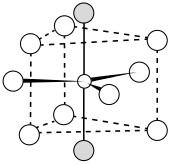Lanthanum trifluoride
Lanthanum trifluoride is a refractory ionic compound of lanthanum and fluorine.[4]
 Crystal structure | |
| Names | |
|---|---|
| Other names
Lanthanum(III) fluoride | |
| Identifiers | |
3D model (JSmol) |
|
| ChemSpider | |
| ECHA InfoCard | 100.033.851 |
| EC Number |
|
PubChem CID |
|
CompTox Dashboard (EPA) |
|
| |
| |
| Properties | |
| LaF3 | |
| Molar mass | 195.900 g/mol[1] |
| Appearance | white, crystalline solid |
| Density | 5.9 g/cm3[1] |
| Melting point | 1,493 °C (2,719 °F; 1,766 K)[1] |
Refractive index (nD) |
1.606 |
| Structure | |
| Rhombohedral, hR24 | |
| P3c1, No. 165[2] | |
a = 0.7185 nm, c = 0.7351 nm | |
Lattice volume (V) |
0.32865 |
Formula units (Z) |
6 |
| Hazards | |
| Safety data sheet | [3] |
| NFPA 704 (fire diamond) | |
Except where otherwise noted, data are given for materials in their standard state (at 25 °C [77 °F], 100 kPa). | |
| Infobox references | |
The LaF3 structure

Bonding is ionic with lanthanum highly coordinated. The cation sits at the center of a trigonal prism. Nine fluorine atoms are close: three at the bottom corners of the trigonal prism, three in the faces of the trigonal prism, and three at top corners of the trigonal prism. There are also two fluorides a little further away above and below the prism. The cation can be considered 9-coordinate or 11-coordinate.[4]
The larger sized rare earth elements (lanthanides), which are those with smaller atomic number, also form trifluorides with the LaF3 structure.[4] Some actinides do as well.
Applications
Lanthanum fluoride is sometimes used as the "high-index" component in multilayer optical elements such as ultraviolet dichroic and narrowband mirrors. Fluorides are among the most commonly used compounds for UV optical coatings due to their relative inertness and transparency in the far ultraviolet (FUV, 100 nm <λ <200 nm). Multilayer reflectors and antireflection coatings are typically composed of pairs of transparent materials, one with a low index of refraction, the other with a high index. There are very few high-index materials in the far UV. LaF3 is one.[5] The material is also a component of multimetal fluoride glasses such as ZBLAN.[6] It is also used (with europium fluoride, EuF2) in fluoride selective electrodes.
References
| Wikimedia Commons has media related to Lanthanum(III) fluoride. |
- Haynes, William M., ed. (2011). CRC Handbook of Chemistry and Physics (92nd ed.). Boca Raton, FL: CRC Press. p. 4.69. ISBN 1439855110.
- Zalkin, A.; Templeton, D. H. (1985). "Refinement of the trigonal crystal structure of lanthanum trifluoride with neutron diffraction data" (PDF). Acta Crystallographica Section B. 41 (2): 91. doi:10.1107/S0108768185001689.
- "Safety Data Sheet: Lanthanum(III) fluoride". Thermo Fisher Scientific. 19 January 2018. Retrieved 17 August 2018.
- Cotton, Simon (30 January 2007). Lanthanide and Actinide Chemistry. Wiley. pp. 25–27. ISBN 978-0-470-01007-5.
- Rodríguez-de Marcos, Luis (23 September 2015). "Multilayers and optical constants of various fluorides in the far UV". Proceedings of SPIE: Advances in Optical Thin Films V. 9627 (B0): 1–10. doi:10.1117/12.2191309. hdl:10261/134764. Retrieved 27 February 2019.
- Harrington, James A. "Infrared Fiber Optics" (PDF). Rutgers University. Archived from the original (PDF) on 9 May 2008.
